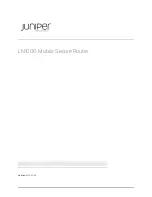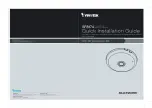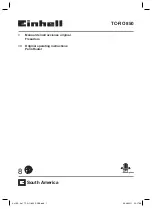
594
Configuring QoS
QoS Treatment for Performance-Monitoring Protocols
You use the
shape average
policy map class configuration command to specify that a class of traffic should have a
maximum permitted average rate. You specify the maximum rate in bits per second.
Class-based-weighted-fair-queuing (CBWFQ)
You can use the
bandwidth
policy-map class configuration command to control the bandwidth allocated to a
specific class. Minimum bandwidth can be specified as a bit rate or a percentage of total bandwidth or of remaining
bandwidth.
Priority queuing or class-based priority queuing
You use the
priority
policy-map class configuration command to specify the priority of a type of traffic over other
types of traffic. You can specify strict priority for the high-priority traffic and allocate any excess bandwidth to other
traffic queues, or specify priority with unconditional policing of high-priority traffic and allocate the known remaining
bandwidth among the other traffic queues.
—
To configure strict priority, use only the
priority
policy-map class configuration command to configure the
priority queue. Use the
bandwidth remaining percent
policy-map class configuration command for the other
traffic classes to allocate the excess bandwidth in the desired ratios.
—
To configure priority with unconditional policing, configure the priority queue by using the
priority
policy-map
class configuration command and the
police
policy-map class configuration command to unconditionally
rate-limit the priority queue. In this case, you can configure the other traffic classes with
bandwidth
or
shape
average
, depending on requirements.
These sections contain additional information about scheduling:
Class-Based Weighted Fair Queuing, page 595
Traffic Shaping
Traffic shaping is a traffic-control mechanism similar to traffic policing. While traffic policing is used in input policy maps,
traffic shaping occurs as traffic leaves an interface. The switch can apply class-based shaping to classes of traffic leaving
an interface and port shaping to all traffic leaving an interface. Configuring a queue for traffic shaping sets the maximum
bandwidth or peak information rate (PIR) of the queue.
Note:
You cannot configure traffic shaping (
shape average
) and CBWFQ (
bandwidth
) or priority queuing (
priority
) for
the same class in an output policy map. You cannot configure traffic shaping for a traffic class when strict priority (priority
without police) is configured for another class within the output policy-map.
Class-Based Shaping
Class-based shaping uses the
shape average
policy-map class configuration command to limit the rate of data
transmission as the number of bits per second to be used for the committed information rate for a class of traffic. The
switch supports separate queues for three classes of traffic. The fourth queue is always the default queue for class
class-default
, unclassified traffic.
Note:
Configuring traffic shaping also automatically sets the minimum bandwidth guarantee or committed information
rate (CIR) of the queue to the same value as the PIR.
Port Shaping
To configure port shaping (a transmit port shaper), create a policy map that contains only a default class, and use the
shape average
command to specify the maximum bandwidth for a port.
Содержание IE 4000
Страница 12: ...8 Configuration Overview Default Settings After Initial Switch Configuration ...
Страница 52: ...48 Configuring Interfaces Monitoring and Maintaining the Interfaces ...
Страница 108: ...104 Configuring Switch Clusters Additional References ...
Страница 128: ...124 Performing Switch Administration Additional References ...
Страница 130: ...126 Configuring PTP ...
Страница 140: ...136 Configuring CIP Additional References ...
Страница 146: ...142 Configuring SDM Templates Configuration Examples for Configuring SDM Templates ...
Страница 192: ...188 Configuring Switch Based Authentication Additional References ...
Страница 244: ...240 Configuring IEEE 802 1x Port Based Authentication Additional References ...
Страница 274: ...270 Configuring SGT Exchange Protocol over TCP SXP and Layer 3 Transport Configuring Cisco TrustSec Caching ...
Страница 298: ...294 Configuring VLANs Additional References ...
Страница 336: ...332 Configuring STP Additional References ...
Страница 408: ...404 Configuring DHCP Additional References ...
Страница 450: ...446 Configuring IGMP Snooping and MVR Additional References ...
Страница 490: ...486 Configuring SPAN and RSPAN Additional References ...
Страница 502: ...498 Configuring Layer 2 NAT ...
Страница 559: ...555 Configuring Network Security with ACLs How to Configure Network Security with ACLs Creating a Numbered Extended ACL ...
Страница 770: ...766 Configuring IPv6 MLD Snooping Related Documents ...
Страница 930: ...926 Configuring IP Unicast Routing Related Documents ...
Страница 956: ...952 Configuring IPv6 Unicast Routing Configuring IPv6 network 2010 AB8 2 48 network 2010 AB8 3 48 exit address family ...
Страница 976: ...972 Configuring Cisco IOS IP SLAs Operations Additional References ...
Страница 978: ...974 Dying Gasp ...
Страница 990: ...986 Configuring Enhanced Object Tracking Monitoring Enhanced Object Tracking ...
Страница 994: ...990 Configuring MODBUS TCP Displaying MODBUS TCP Information ...
Страница 996: ...992 Ethernet CFM ...
Страница 1030: ...1026 Working with the Cisco IOS File System Configuration Files and Software Images Working with Software Images ...
Страница 1066: ...1062 Using an SD Card SD Card Alarms ...
















































